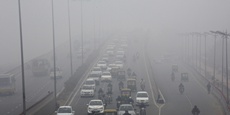NGT to study odd-even scheme as Delhi breathes just a little easier
10 Nov 2017
The National Green Tribunal (NGT) today said it would examine later in the day the Delhi government's decision to implement the odd-even car rationing scheme for five days starting from 13 November.
 The Aam Admi Party government had on Thursday announced introduction of the odd-even scheme as part of its Graded Response Plan to tackle the alarming pollution in the national capital. Parking fees have also been hiked from Rs20 to Rs80 per hour.
The Aam Admi Party government had on Thursday announced introduction of the odd-even scheme as part of its Graded Response Plan to tackle the alarming pollution in the national capital. Parking fees have also been hiked from Rs20 to Rs80 per hour.
Meanwhile Delhi's air quality remained ''severe'' for the fourth consecutive day this morning, although visibility as well as particulate matter levels seemed to show some improvement.
India Metrological Department (IMD) officials said the minimum visibility stood at 400 metres, better than Thursday's 200 metres.
Foggy conditions are declared when visibility goes below 1,000 metres.
The state government has started spraying water on the roads and surrounding vegetation in an attempt to make the particulate matter settle.
On the odd-even scheme, a bench headed by NGT chairperson Justice Swatanter Kumar directed the Delhi government to submit before it the details of the ambient air quality during the implementation of the scheme.
The green panel directed the counsel appearing for the Delhi government to be ready with all the requisite data and show before it the reason for implementing the latest odd-even scheme.
On 21 April last year, the Central Pollution Control Board (CPCB) had told NGT that there was no data to suggest that the odd-even scheme led to a decline in vehicular pollution in Delhi NCR, and the fluctuations in PM10 and PM2.5 was due to weather and change in wind patterns.
The national capital is experiencing 'severe' air quality as defined by the CPCB and is under a blanket of thick haze.
Friday was coldest day of the early winter season, with the minimum temperature dipping to 13 degrees Celsius. Thursday, which registered a minimum temperature of 13.8 degrees Celsius, was the second coldest so far.
The air quality index (AQI) recorded at 7.30 am was 483, a very small drop from Thursday's average of 486, signifying that it still remained in the severe zone. Later, at 9 am, it rose to 484 while Ghaziabad stood at 498, Gurgaon at 485 and Noida at 485 – inching towards distressing levels.
Punjab farmers protest
In Punjab, farmers on Thursday blocked the Mansa-Bathinda State Highway demanding early lifting of paddy from mandis, which was hit due to rise in moisture level in the crop over the past few days.
Farmers complained that because of smog and lack of sunlight moisture level in the crop had risen up to 25 per cent. Paddy with moisture level of 17 per cent is recommended for lifting.
After farmers blocked the state highway for close to two hours, SDM, Mansa ordered lifting of paddy. Reports said paddy with moisture content of up to 21 per cent was lifted on Thursday.
The road blockade, which increased the threat of accidents amid dense smog, was organised by Bharti Kisan Union (Ugrahan).At the Delhi Technological University station, the AQI maxed out at 500.
The situation in major cities across the northern belt remained grim too, with Agra registering 409, Bhiwadi 457, Faridabad 440, Kanpur 428, Lucknow 471, Muzaffarpur 431 and Varanasi 463.
The AQI ranges from 0-500, with 500 as the worst possible air quality.
Indian Railway officials said 48 trains were delayed, one cancelled and seven rescheduled.
On Thursday, particulate matter levels declined for the first time since 7 November, when pollution levels surpassed the ''severe'' category in Delhi NCR. The IMD forecast states that the AQI will return to ''very poor'' levels from ''severe'' by Saturday.
SAFAR – which is affiliated to the Union ministry of earth sciences – had predicted that levels of particulate matter would drop by 30 per cent by Friday.
The average level of PM10 in the NCR, which had earlier shot up to over 800ug/m3, dropped to less than 750 ug/m3 by 6 pm on Thursday. The PM2.5 level also dropped from 600 ug/m3 to around 550 ug/m3.
Airtel, a key sponsor of the Delhi Half Marathon scheduled for 19 November, has threatened to pull out if the air quality does not improve by then. Real-time air quality data collected by members of the Help Delhi Breathe and #MyRightToBreathe collective from five locations along the marathon's 20-km stretch showed that particulate matter pollution still stood at dangerous levels.
''The air quality has started improving, and weather conditions will get much better by Saturday. Odd-even would have been more effective if it was done in the last three days,'' D Saha, who heads the air quality laboratory at the CPCB, said on Thursday.






























